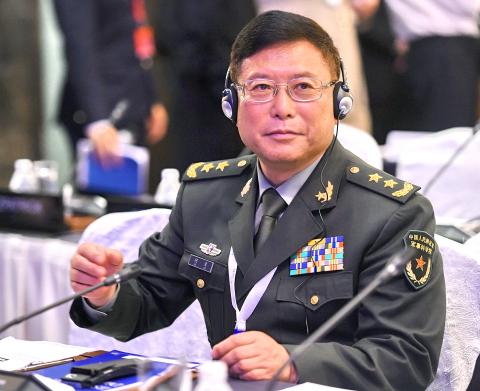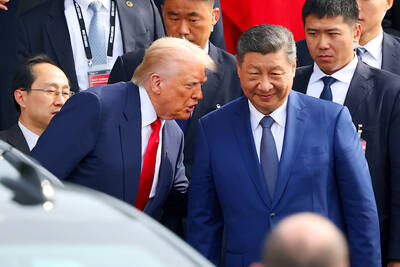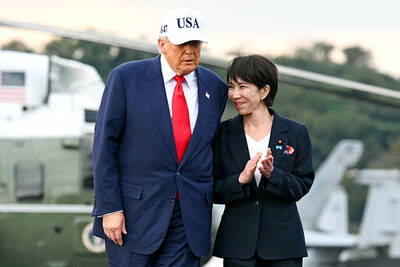Several Asian nations are seeking to bolster informal alliances among themselves, regional diplomats and officials said, unsettled by growing fears that the US could not be relied on to maintain a buffer against China’s assertiveness.
Countries including Australia, Japan, India and Vietnam are quietly stepping up discussions and co-operation, although taking care they do not upset Beijing, the diplomats said.
No one was yet talking about a formal alliance.

PHOTO: AFP
Inaugurating the weekend Shangri-La Dialogue, the region’s premier security forum, Australian Prime Minister Malcolm Turnbull said: “In this brave new world we cannot rely on great powers to safeguard our interests.”
“We have to take responsibility for our own security and prosperity while recognizing we are stronger when sharing the burden of collective leadership with trusted partners and friends,” he said.
His comments resonated through the three-day meeting that ended yesterday.
US Secretary of Defense Jim Mattis told the Singapore forum that Washington remained committed to the region and insisted it would oppose China’s militarization of the disputed South China Sea, one of Asia’s most volatile hot spots.
Regional officials said they were worried by US President Donald Trump’s unpredictability and concerned that his warm praise of Chinese President Xi Jinping (習近平) after their first summit meeting in April would influence decisions on Asia.
“We trust Mattis and we trust [US Pacific Commander Admiral Harry] Harris but at the very top? The trust gap is very wide,” one senior Asian military officer said. “Our fear is driven by the reality that it is only the US that is powerful enough to set red lines with China.”
In broad terms, Singaporean Minister of Defense Ng Eng Hen (黃永宏) confirmed accelerated co-operation among partners, but he also said he welcomed Mattis’ reassurances.
“Countries look at the landscape and you adjust, and that’s what good leadership does ... you put yourself in a position so if there are changes, you are not caught completely off-guard,” Ng said at a news conference yesterday.
Australia, New Zealand, Britain, Malaysia and Singapore re-energised their Five Powers Defence Agreement on the weekend, with officials saying they wanted to better link new military capabilities, as well as boost counter-terrorism efforts and maritime security.
Beijing sent a low-key delegation to the Shangri-La forum this year, but its officials were warily watching developments and warning of “Cold War thinking” behind moves to strengthen alliances.
“It’s a Cold War mentality to use alliances to check on China,” said Senior Colonel Zhao Xiaozhuo (趙小卓), of the People’s Liberation Army’s Academy of Military Science. “It’s creating some sort of threat and using China as a threat is a huge mistake.”

UKRAINE, NVIDIA: The US leader said the subject of Russia’s war had come up ‘very strongly,’ while Jenson Huang was hoping that the conversation was good Chinese President Xi Jinping (習近平) and US President Donald Trump had differing takes following their meeting in Busan, South Korea, yesterday. Xi said that the two sides should complete follow-up work as soon as possible to deliver tangible results that would provide “peace of mind” to China, the US and the rest of the world, while Trump hailed the “great success” of the talks. The two discussed trade, including a deal to reduce tariffs slapped on China for its role in the fentanyl trade, as well as cooperation in ending the war in Ukraine, among other issues, but they did not mention

Japanese Prime Minister Sanae Takaichi yesterday lavished US President Donald Trump with praise and vows of a “golden age” of ties on his visit to Tokyo, before inking a deal with Washington aimed at securing critical minerals. Takaichi — Japan’s first female prime minister — pulled out all the stops for Trump in her opening test on the international stage and even announced that she would nominate him for a Nobel Peace Prize, the White House said. Trump has become increasingly focused on the Nobel since his return to power in January and claims to have ended several conflicts around the world,

GLOBAL PROJECT: Underseas cables ‘are the nervous system of democratic connectivity,’ which is under stress, Member of the European Parliament Rihards Kols said The government yesterday launched an initiative to promote global cooperation on improved security of undersea cables, following reported disruptions of such cables near Taiwan and around the world. The Management Initiative on International Undersea Cables aims to “bring together stakeholders, align standards, promote best practices and turn shared concerns into beneficial cooperation,” Minister of Foreign Affairs Lin Chia-lung (林佳龍) said at a seminar in Taipei. The project would be known as “RISK,” an acronym for risk mitigation, information sharing, systemic reform and knowledge building, he said at the seminar, titled “Taiwan-Europe Subsea Cable Security Cooperation Forum.” Taiwan sits at a vital junction on

LONG-HELD POSITION: Washington has repeatedly and clearly reiterated its support for Taiwan and its long-term policy, the Ministry of Foreign Affairs said US Secretary of State Marco Rubio yesterday said that Taiwan should not be concerned about being used as a bargaining chip in the ongoing US-China trade talks. “I don’t think you’re going to see some trade deal where, if what people are worried about is, we’re going to get some trade deal or we’re going to get favorable treatment on trade in exchange for walking away from Taiwan,” Rubio told reporters aboard his airplane traveling between Israel and Qatar en route to Asia. “No one is contemplating that,” Reuters quoted Rubio as saying. A US Treasury spokesman yesterday told reporters